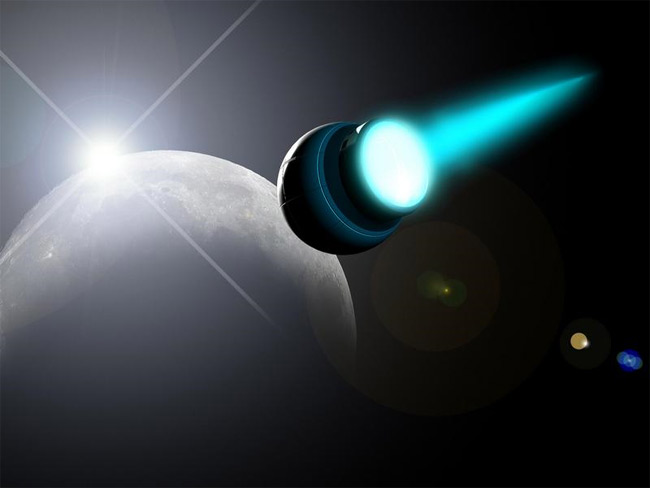Underdog Team Aims For Moon

Nearly 40 years after Americans first set foot on themoon on July 20, 1969 with NASA's historic Apollo 11 flight, a host of privaterocketeers are hoping to follow to win a $30 million prize. Here, SPACE.comlooks at Lunatrex, one of 17 teams competing in the Google Lunar X Prize:
Lunatrex may have considered itself an underdog in the racefor the Google Lunar X PRIZE, but the team now realizes that itsslow-but-steady approach just might work.
"I feel very good about our team?s chances," said Pete Bitar, Lunatrex team leader. "Our approach is very sober, very realistic, with plentyof margin and room for error?it?s got risks, but the risks all have hedges."
That approach is encapsulated in the team's plan to use anelectric propulsion engine to reach the moon over several months, rather thandays. Spacecraft such as Deep Space 1 and the Dawnprobe have used such engines to shoot a stream of charged particles out andslowly accelerate.
Once the spacecraft reaches the moon, the GoogleLunar X Prize requires teams to land a robot on the moon, move at least1,640 feet (500 meters) and beam high definition views back to Earth.
The Lunatrex spacecraft would build up speed in Earth orbit beforesetting off for its lunar destination, giving the team plenty of time to adjustif needed.
"For any course correction you have weeks, notminutes," Bitar told SPACE.com, pointing out that the gradualresponse contrasts with short missions that need many things to happen in ashort amount of time.
Get the Space.com Newsletter
Breaking space news, the latest updates on rocket launches, skywatching events and more!
Other advantages include using tested off-the-shelftechnology, which again reduces the mission risks. Electric propulsion enginesalso use less fuel than conventional engines, which would cut both fuel andlaunch costs for Lunatrex.
"Our approach made sense not just to us, but to a lotof bigger players too," Bitar noted. "Both from a businessdevelopment and launch attempt, we?re taking it very cautiously."
Perhaps the most unusual features of the Lunatrex plan involvethe rovers. One rover concept resembles an inchworm that uses piezoelectric"muscles" to scoot along the lunar surface. Another rover could usean icosahedrons shape with 12 telescoping legs that slowly "walk" inany direction ? the legs would handily double as the transceiver antennae.
Bitar did not rule out more conventional rovers, butemphasized a final design the size of a shoebox. Either way, the rover inwhatever form would shoot high definition video in multiple directions tocreate a 360 degrees composite view.
The team is focusing on "far and away the hardestpart" of achieving a successfulmoon landing, but even a failed landing attempt would not scuttle itsplans.
"If we?re successful in orbiting the moon, and for somereason the landing fails, you?ve done 85-90 percent of the work in the minds ofa lot of people," Bitar observed. "We may take a second shot at theprize if we have enough confidence from the market."
Lunatrex has even declared it may launch multiple lunarmissions anyway, in an attempt to snag both first and second place for the XPRIZE and take the entire $30 million purse.
However, the team clearly has ambitions beyond the X PRIZE.
"It's a two-pronged mission," Bitar said."We're obviously competing for the X PRIZE, but along the way we want tocome up with as many things to hedge out bets and create an income stream downthe road."
The team's business approach stems from Bitar's experience headingcompanies that have attracted attention with big ideas. Xtreme AlternativeDefense Systems landed several U.S. military contracts in the past to developunusual non-lethal weapons, while Airbuoyant has begun selling the VertiPod, anultralight vehicle with the capabilities of a personal helicopter.
Lunatrex hopes to land both small and big partners withtheir low cost approach, but Bitar won't rely only on funding from partners andsponsors. He has promised that proceeds from VertiPod sales will go towardslifting Lunatrex moonward.
- New Video - Balloon Launcher to Shoot for the Moon
- Video - Moon 2.0: Join the Revolution
- Image Gallery - Full Moon Fever
Join our Space Forums to keep talking space on the latest missions, night sky and more! And if you have a news tip, correction or comment, let us know at: community@space.com.
Jeremy Hsu is science writer based in New York City whose work has appeared in Scientific American, Discovery Magazine, Backchannel, Wired.com and IEEE Spectrum, among others. He joined the Space.com and Live Science teams in 2010 as a Senior Writer and is currently the Editor-in-Chief of Indicate Media. Jeremy studied history and sociology of science at the University of Pennsylvania, and earned a master's degree in journalism from the NYU Science, Health and Environmental Reporting Program. You can find Jeremy's latest project on Twitter.









